
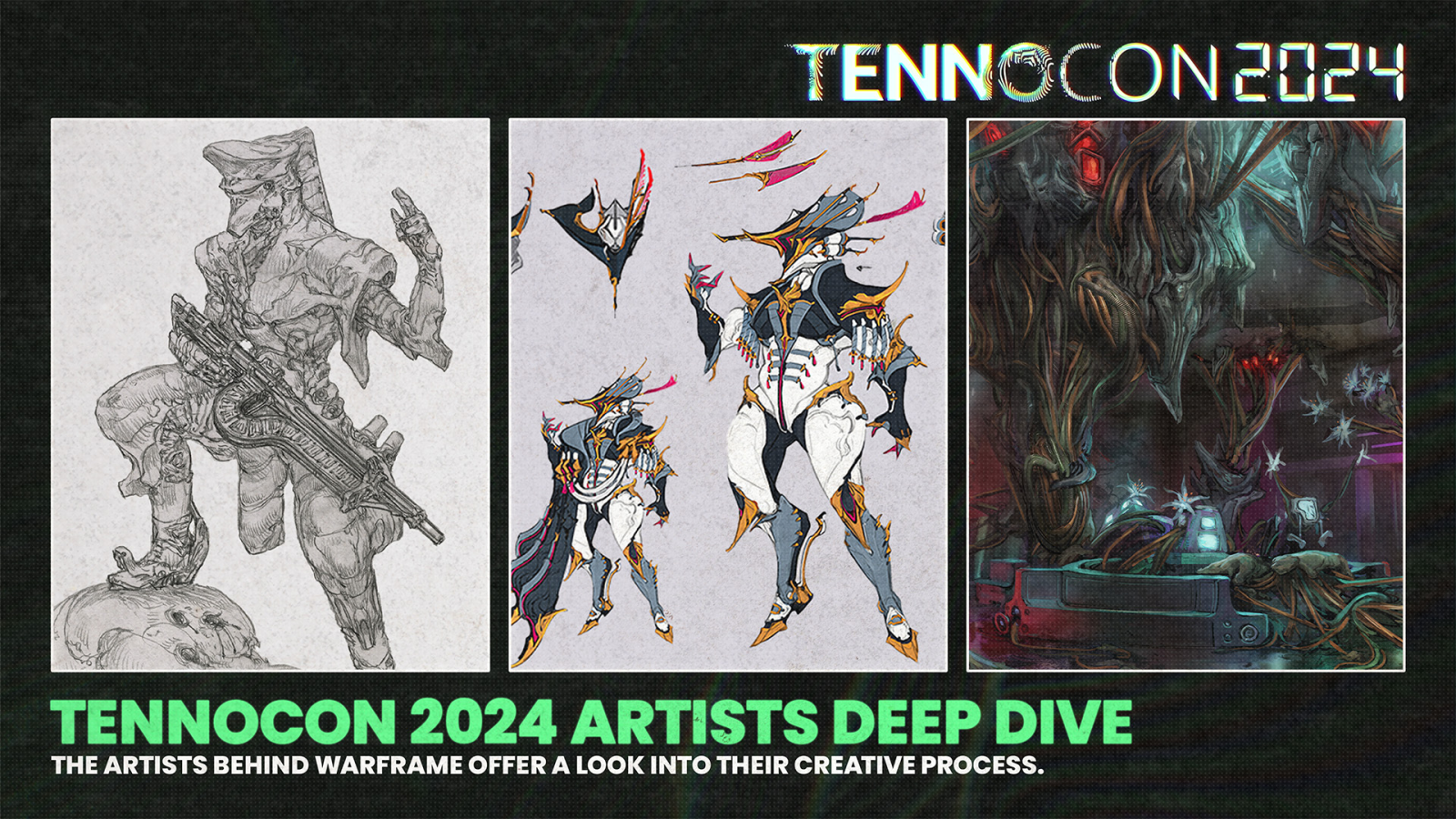
Breathing life into an entire solar system is no easy task, but Warframe’s art team does it on a regular basis. At TennoCon 2024, several key artists responsible for everything from the beating heart of Deimos to Fortuna’s bustling streets spoke all about some of their most recent creations and how they give the Origin System so much character — one brushstroke at a time.
Artist: Liger Inuzuka
Subject: Sevagoth & Exalted Prime Shadow Concepts
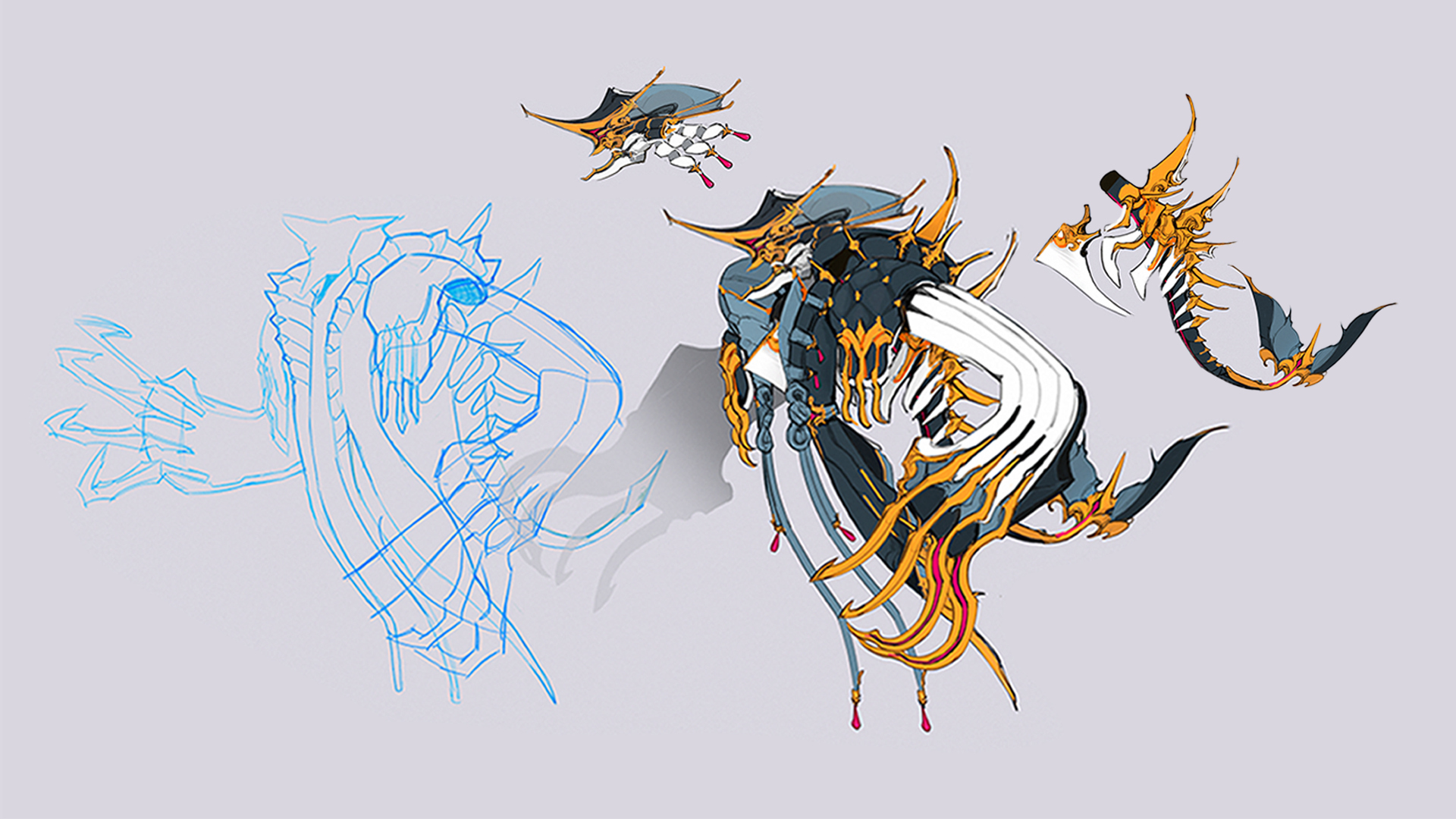
Thank you for asking about my work on Sevagoth Prime; I'd love to speak of him as a whole. First, you may notice that, in stark contrast to my previous artworks, concept art for Sevagoth and his Prime look more unrefined as a collection of drawings and explorations rather than a single complete art piece. I apologize for this. His design process spanned many years as my availability changed, ideas changed, and even my directions changed. Sometimes deadlines require that and what resulted was a collection of drawings from which the final Sevagoth Prime was forged.
That being said, Sevagoth Prime's design begins with his base form, which was actually my final exam art piece in a college course at the time. My version of Sevagoth himself was buried in a crashed Tenno ship under the ice of Europa, sending out a distress signal that was never discovered, until the Corpus/Grineer mining operations dug deep enough to catch said signal and uncover the ship. This Warframe spent so long trapped, it began to decay leading into its current decrepit appearance — while its indomitable will to continue its mission manifested the "Shadow" to work beyond the restrictions of its body.
The concept story of my thesis work changed, but the core idea was kept. Sevagoth is now a lost ship captain in the void. This decrepit appearance — with biomechanical muscles hanging off his body, his skeleton poking through, and even missing skin — all suggest that Sevagoth was once whole. I wanted to show this narrative through the base, Deluxe, and Prime lines. Sevagoth Deluxe would be the true "original" form of Sevagoth, while the Prime is of course the original Orokin design.
However, this provided many challenges. How could each of the three forms be unique enough to warrant its own existence and appeal to the players, but remain similar enough to show this narrative through their visuals? Furthermore, the lore could be a point of critique, as rarely did Deluxe skins ever touch on real, canon storytelling. Would players like this direction? Would my Leads? Eventually, after so much work, this idea was scrapped and I pivoted the Deluxe differently towards the haunted, sunken Greco-Warrior theme of Sevagoth Glaukus. Given that I also created Hydroid Rakkam, another sea-themed Warframe, and the fact that I was inspired by the tale of Bootstrap Bill in Pirates of the Caribbean, I made up my own "fan fiction," if you'd like to call it that, of these Deluxe skins and their story.
During this time creating this narrative "line," I already had ideas for Sevagoth Prime inspired by historical seafaring fashions of the 18th century, and the more dramatic Roccoco or "Late Baroque" style of architecture, art and decoration. You may notice this direction is quite different from the dark and tragic Sevagoth and his Deluxe Skin. This was intentional.
First, I wanted to differentiate him from the original intention of the now-scrapped, creature-like "canon" Sevagoth Deluxe. Second, I had to elevate his status as he once was part of the Orokin empire. What was that Orokin ship captain Warframe like long ago, before the tragic mission that left him stranded in the Void leading to his decrepit appearance? I believed it would also be a unique idea to explore the appearance of Roccoco art in the Warframe Orokin style. Both are exceptionally ornamental, golden art styles. Thematically appropriate, as the Roccoco style began approximately in the early 18th century — not unlike the era of these pirates and sea captains I wanted to capture in the ongoing theme of Sevagoth's story. Down to his captain's coat, feathered hats, and even he and his Shadow both wearing wigs. I have no explanation for the Shadow in this Prime context, as the Shadow is a manifestation that appears after Sevagoth's story. Perhaps that is up to the writers… or the players!
Unfortunately, for various reasons I had not the time to fully complete my vision, and Sevagoth Prime was left in this collection of drawings from which my dear colleagues in the Characters team had to scrape together a 3D sculpture. We worked together to still bring this vision to life, and I am proud of and honored to work with them. It is still a magical feeling to see little ideas I draw come to life through Warframe, never diminishing even after each and every time.
Artist: Kory Cromie
Subject: Cyte-09 Concept
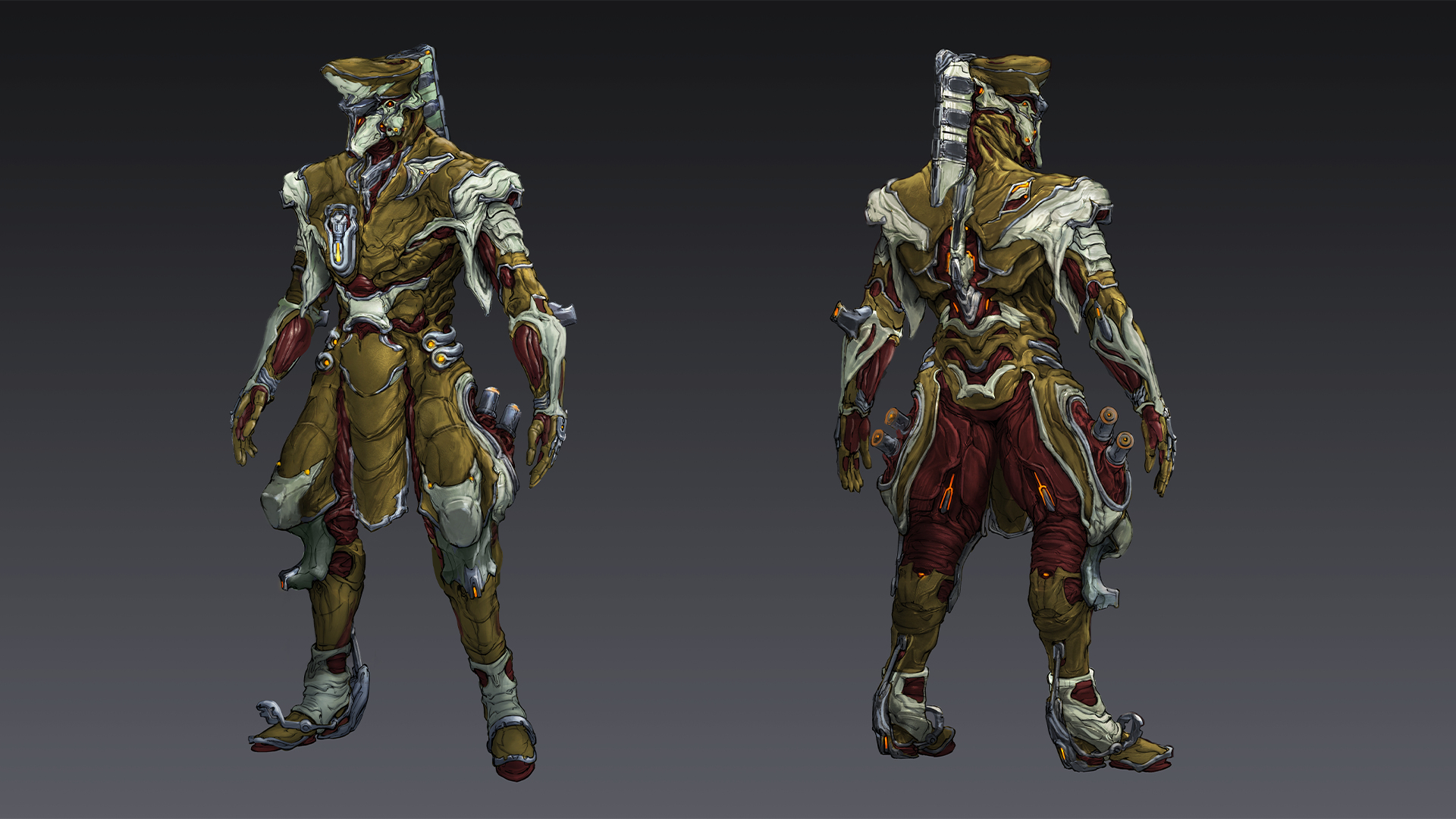
I was tasked with completing the concept for Cyte-9, the Weapon specialist Warframe and the first-ever character I had been assigned to work on. Based on a sketch by Keith Thompson, I looked for further reference and inspiration based on the drawing and description he provided, which mentioned that Cyte-9 (originally called Frumentarius) was able to be a kind of saboteur/partisan style of fighter, able to operate and supply allies behind enemy lines.
I referenced early 20th century foreign legions and irregular resistance fighters to flesh out his details and gadgets, and to give him the look of a classical, fully equipped soldier. Somebody who would be ready for any situation.
Many ideas were tried with his gadgets. At one point it was even proposed that he would have transforming arms that would change to use his different abilities. However, that proved to be too complex to use in conjunction with various systems in the game, and he was ultimately given more straightforward arms.
I completed the design of Cyte-9 as a retro-future soldier who looks like he could be a weapon in his own right, my favourite detail being the ponytail on his head that looks slightly like an ammo bandolier.
Artist: Kory Cromie
Subject: Infested Mall Concept
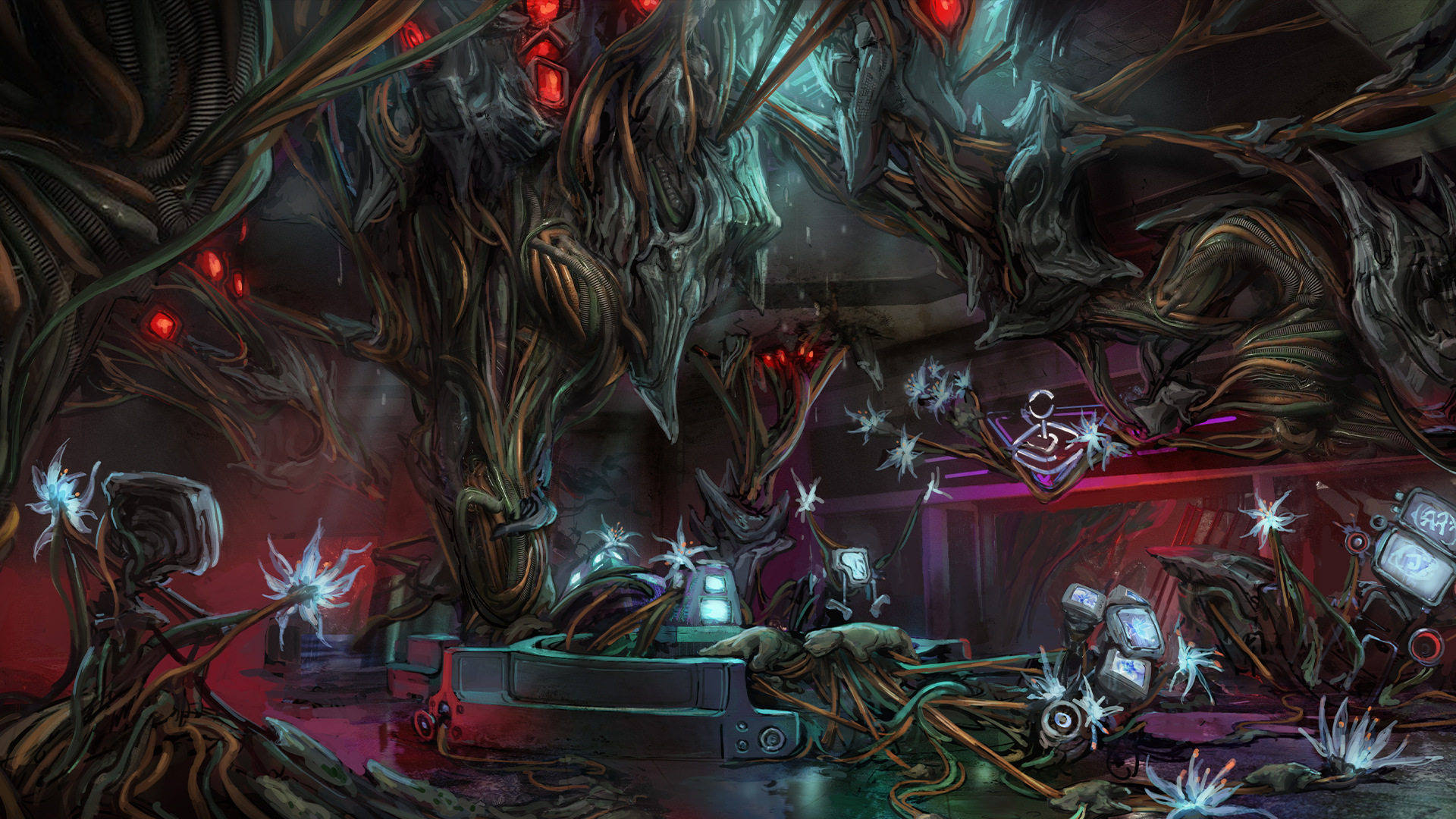
For Warframe: 1999, a new prototype form of the Infested was going to be featured in the game. This earlier version of the Infested was intended to have a more obvious dependence on technology. I was assigned to create various concepts for these "Proto-Infested," coming up with ideas for how they can look distinct, how they propagate and spread through technology, and just their overall look and feel. The Infested mall concept was intended to show what the general look of a high level of Infestation would appear like an interior environment.
I designed different ways for the Infested to attach to and ingest technology, allowing it to propagate and grow, by referencing era appropriate TVs, arcade games, and other electronics for the Infested to seek out and attempt to replicate, creating anglerfish-like lures out of the technology for potential victims.
I also referenced jungles and abandoned malls with their liminal spaces to come up with compositions and shape language for the infested vines and growths, while also trying to imply different stages of the Proto-Infested development. New growth is closer to the ground with a blue glow to it, while the advanced growth is higher up and glowing red, creating an ominous look to the environment.
Artist: Antonio Sánchez
Subject: Sevagoth Prime Modeling
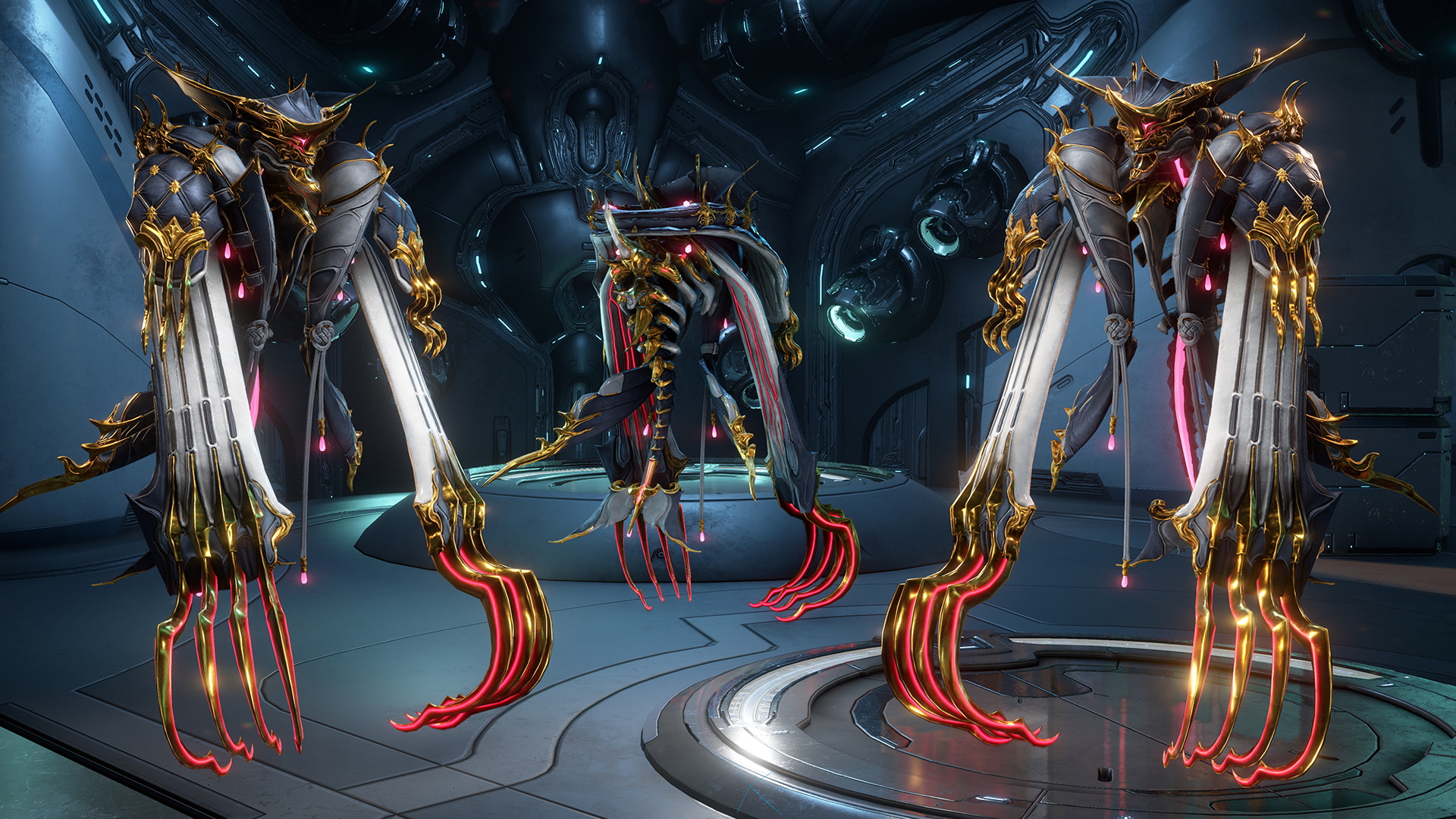
What is the process of turning a 2D concept into a full 3D model? Especially one with such complex detailing?
Converting a 2D concept into 3D is something really complex that encompasses many areas of knowledge, a lot of practice, and a lot of feedback back and forth with the concept artist and art direction. The main complexity of this process lies in the very nature of the medium. That is, in 2D something can work and look great, but when you translate this to 3D it sometimes looks horrible or simply does not work.
For example: a detail in which a front view looks very nice, but in profile or three-quarters it is simply impossible to do because it does not have a logical translation to the three-dimensional world. It is at this moment where our criteria, vision and practice as modelers and our modest skills as "designers" play a really important role, because you must create or interpret new objects that must work when seen from any angle.
I'm not going to lie to you, it is a process that is sometimes tedious and complex, but as the agreement between the concept and the 3D is achieved, it generates a lot of satisfaction. Even more so when you have the opportunity to work with such good concept artists.
When everything begins to flow in the right direction and the final moment approaches, it is very enriching and gratifying and if on top of that all this is well received by the public it is the most pleasant and fulfilling.
Any interesting moments during the modeling process that you'd like to share with the players?
In general, all the stages have their own particularities, but there is a moment in which the general shapes are already in their right place, everything works from all angles and you start, little by little, to add small details. It is a great moment in which everything begins to flow and you can relax more. It is a moment in which I personally like to work with music the most and it is like a kind of meditation, you forget absolutely everything and your mind goes blank at times, as if flowing with the pencil, and even more so when the feedback of everything you add is positive… That's great.
Sevagoth is already a pretty complex frame in terms of design, how do you tackle not only a Warframe but ALSO its Exalted Shadow?
Well, trying to transfer all that conceptual base that has already been translated into 3D correctly in the main character… Sometimes copying certain details that already work in the main character and adapting them to his Shadow is a little simpler because the work of "translation" — or transfer to 3D — has already been done with the main character.
However, it is not always that linear. Sometimes you go back and forth between the Shadow and the main character; sometimes it is a more dynamic process, and other times less so.
Are there any fun characteristics from the Warframe that you really enjoyed working on?
Honestly, there are two moments which I really enjoy: the first part, in which everything is faster and freer, and more sketchy, as well as the last, in which, after all the effort of the process, the end begins to be glimpsed, as if everything begins to converge. It is really exciting to see how little by little the effort of so many creatives generates the birth of a new character with its own personality and character that represents the essence of the concept. Provided that everything before has been done well, which is not easy.
Special mention to the riggers and animators who, after their black magic, really give life to the characters. For me it is one of the most exciting parts of my job. It is as if the character finally came to life
Artist: Fillipe Bento
Subject: Cyte-09 Model
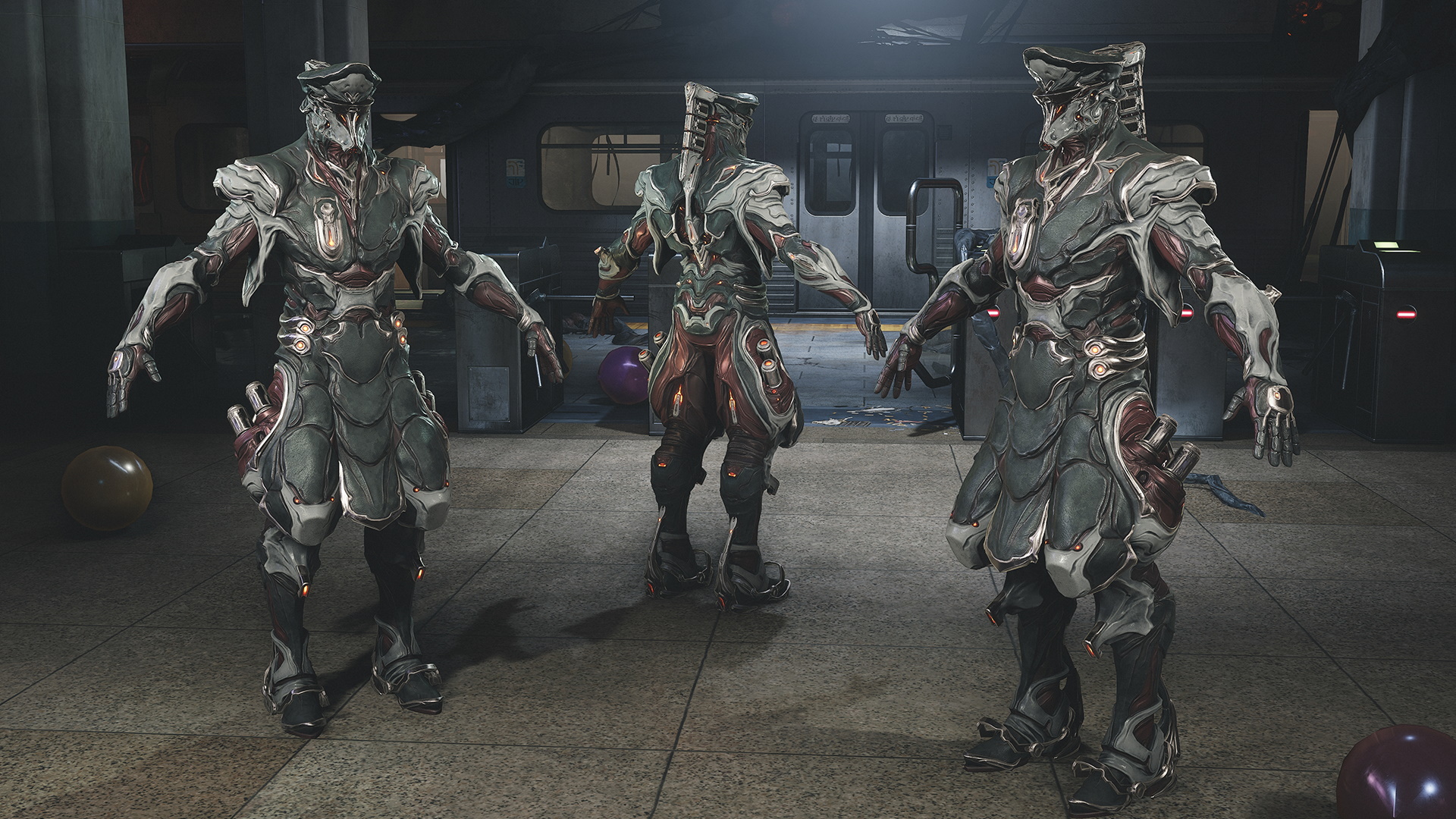
The opportunity to create a new Warframe is always a pleasure, and Cyte-09 brought with it the unique challenge of revisiting the influences that make Warframe's style so distinct and memorable. The concept behind Cyte-09 is rich with both objective and subjective details, which we, as character artists, have the privilege of translating into 3D, enhancing the overall message it conveys. The military theme is unmistakable, especially evident in the helmet's silhouette. One can envision a military uniform with broad shoulders providing a clear and objective visual reference. Delving into a more subjective interpretation, the lines of Cyte-09 suggest organic parts with points of contraction and relief, resembling a muscular carapace that mimics a military uniform.
Creating Cyte-09 was a collaborative journey involving close cooperation with art direction and the concept artist. This process allowed the original idea to evolve, gaining new emphases and refinements along the way. The freedom and teamwork inherent in this process were crucial, ultimately resulting in the Warframe we see today.
I hope Cyte-09 becomes a part of the memorable moments you share with friends within the game. Happy gaming!
Artist: Keith Thompson
Subject: Cyte-09 Concept
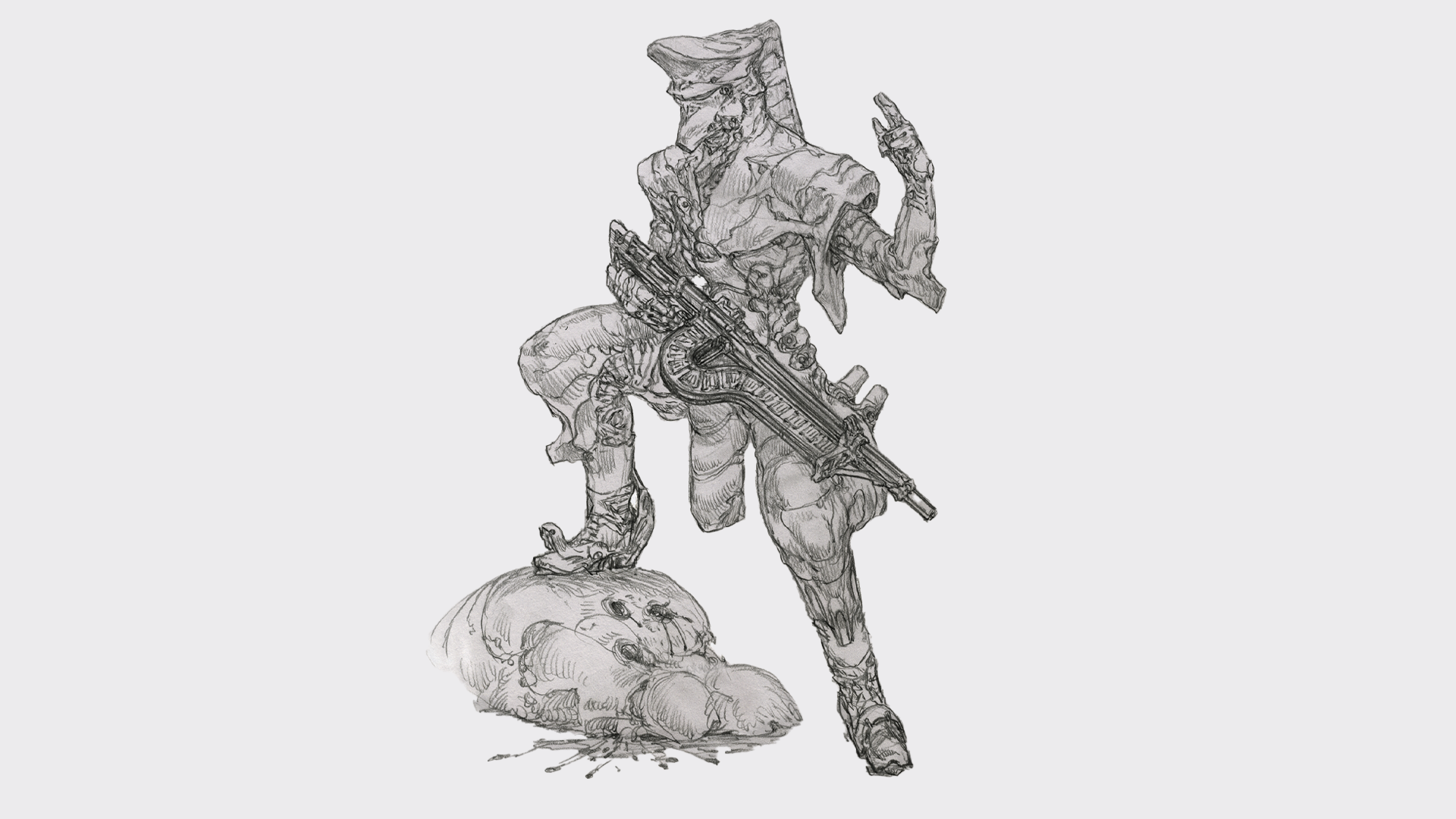
When first conceptualizing a new warframe design I try to find an interesting new hook in their tone and feel. I imagine how they act and the impression they give before any themes or specifics form. Cyte-09 was to cut a sinister and militaristic figure. The pose of the design is integral to this character, and I can’t imagine many other frames posing quite like this. Every frame’s unique weapon is also an integral part of their character and they get designed for the first time in the same art as the frame. Cyte-09's first impression would definitely be a pragmatic-looking ranged weapon. If I start to come up with more fringe designs, I’ll think back to the original roster of frames and imagine how the new one would fit in with them. Keeping that core Warframe identity is very important to my process when designing new frames after making so many and after so much time.
I always try to plan out their abilities and play style, but this often gets adapted to new things once the frame is actually adopted and gets underway. Originally, when Cyte-09 was still called Frumentarius, he was a sort of psy-ops officer type support character, with chemical and psycho-active type weapons and abilities which would confuse and poison enemies. I imagined a pacing of somewhat slower methodical engagement at first with the power effects cascading and ramping up to huge levels as they pile up (with the fighting pace also accelerating as Cyte-09 takes advantage of all the weaknesses he’s seeded around him).
Artist: Fyodor Postnov
Subject: AX-52
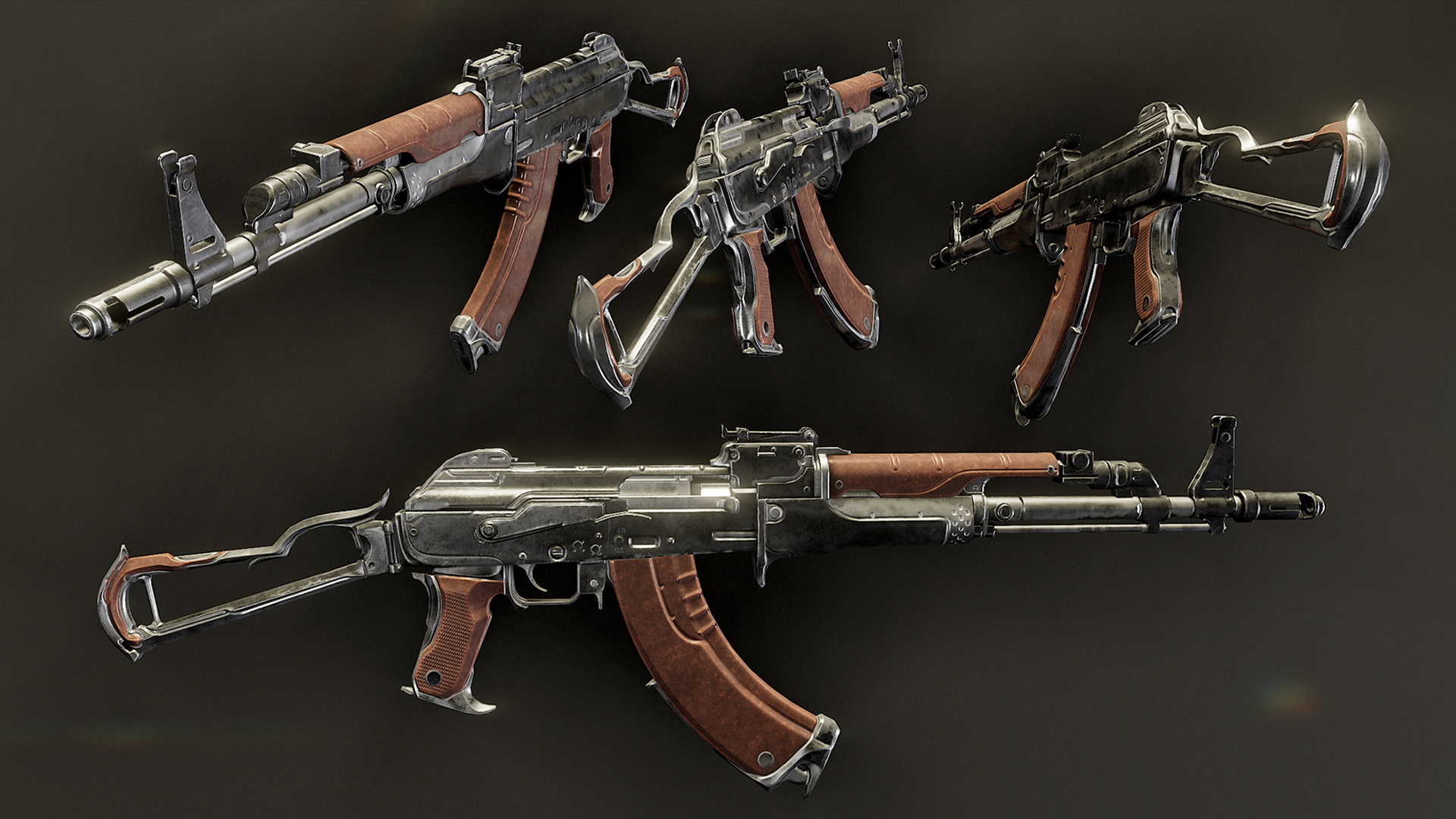
It was my pleasure to bring to reality the AX-52, basing it on the incredible concept art by Vadim Sverdlov. The weapon design bridges the gap between the weapon design of the real world and an Orokin-reminiscent design language. Requiring precision, the AX-52 needed its basic forms blocked out using traditional poly modeling, which were then sculpted over to bring smaller, softer details to its structure. Smaller technical parts, such as the sights, the gas tube, and the bolt were modified from the original AK to varying degrees to match the design goals, while maintaining authenticity. Texturing the weapon required references to real-world materials and typical AK wear and tear, while bringing the familiar, fantastical materials associated with the game to a realistic weapon.
Artist: Nikita Leshakov
Subject: Grenade Launcher
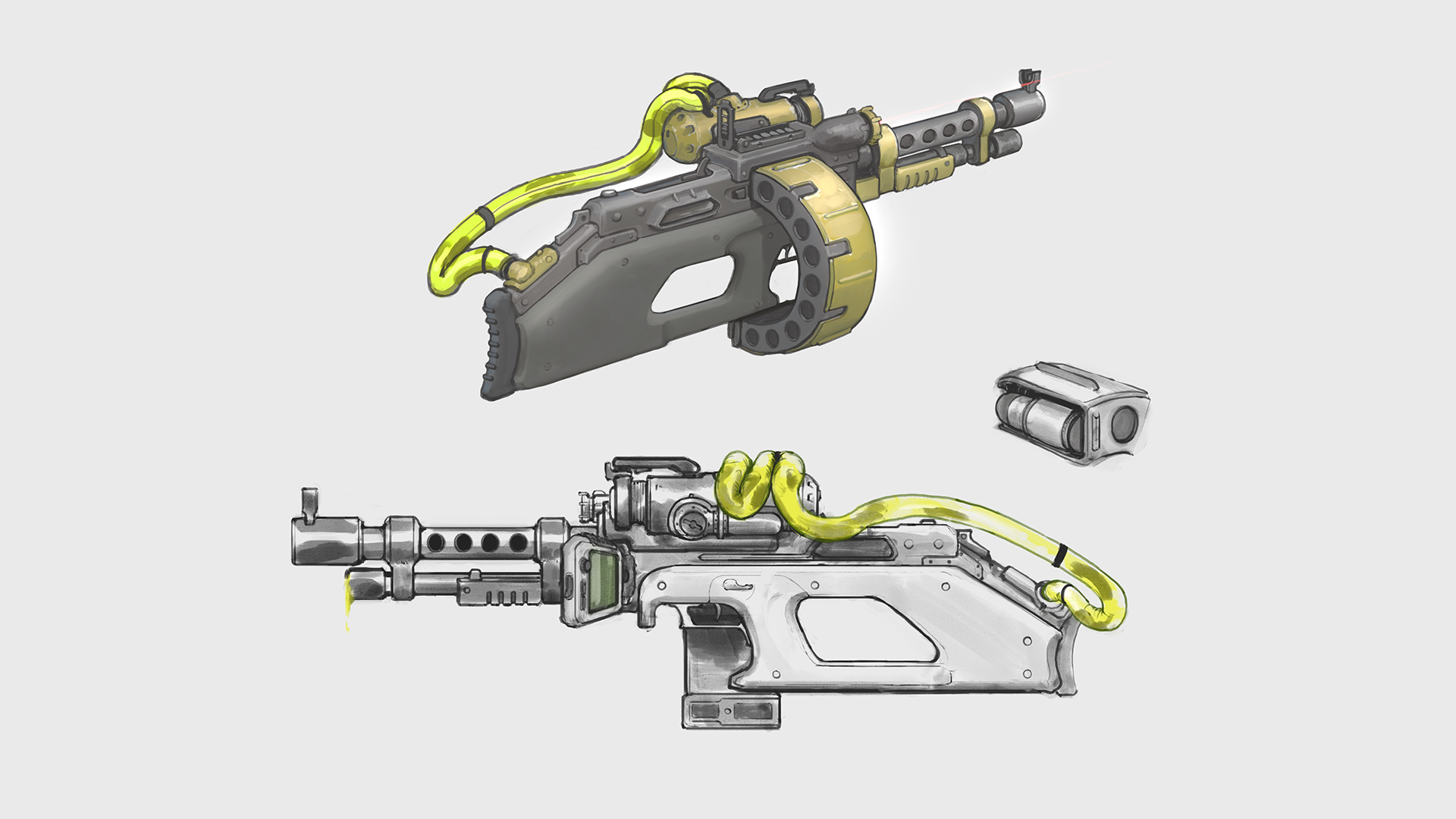
Designing weapons that belong in the 1999 era was certainly a change of pace for me and the rest of the team. Something we always try to do with our weapons is focus on form over function. They are very much not realistic, with a lot of the “function” hand waved away with "it’s magic, I ain’t gotta explain s***." Even the few seemingly functional parts still only exist to complete our guns in a visual sense, not a realistic one. Guns just look better when you can recognize distinct, though somewhat impressionistic, gun parts. Especially if they can be made to animate in an interesting way, further driving the impression of a functional sci-fi gun without having to commit to anything approaching real gunsmithing.
That was very much not the case with 1999. For the story we want to tell and the experience we want to convey, things need to look far more believable and contemporary. However, for it to be artistically satisfying (and legally safe), exactly copying existing real life armaments won’t do, either.
While some of what we’ve made are variations or remixes of existing stuff, like the AX-52 (designed by the very talented Vadim Sverdlov) that sort of started it all, another Warframe: 1999 weapon that comes to mind isn't based on any real firearm. Instead, it’s a product of several separate ideas:
A suggestion from Mike Skyers, our principal character artist, was to look at something like those weird, fictional automatic shotguns from The Matrix, which served as an inspiration for the overall form as something that could be used one-handed (as a potential need for enemy use).
Our game designers wanted a grenade launcher for one of the enemy types, and Pablo picked out this particular design, back then just a shotgun, as fitting for that role.
On my end, I’ve been looking at late 20th century prototypes, such as the OICW XM29, and the final design is sort of an alt-history take on the same concept which would have later been gutted and repurposed for anti-Technocyte use.





















